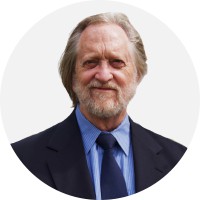The views expressed in our content reflect individual perspectives and do not represent the authoritative views of the Baha'i Faith.
Do the divine prophets and messengers — the founders of religions and entire civilizations — function as “mirrors” of the Creator?
One useful analogy for explaining this intermediary relationship between God and humankind is by means of a figurative image comparing these lofty figures to mirrors, a conceit employed frequently by Abdu’l-Baha, the son of Baha’u’llah, the prophet and founder of the Baha’i Faith. However, when this analogy is incorrectly understood and applied, it can fail to elucidate the concept it is intended to explain. Indeed, it can confuse the entire issue of the ontology of the prophets.
RELATED: All the Prophets: One and the Same Soul
Using this analogy, Abdu’l-Baha compares the manifestation to a perfect mirror, because the manifestation has the power to convey flawlessly all the infinite attributes of God. In this sense, the manifestation can correctly be described as a mirror image of the Creator, though ever remaining essentially distinct from the Creator. Thus, Abdu’l-Baha explained that the manifestation, while conveying to us the bounties of God, is not identical with God’s essence, just as a reflection of the sun in a mirror, bright and blinding as it may be, is not the actual sun.
Nor is the manifestation a piece of God, the incarnation of God on Earth. Thus, the mirror is the means by which we receive the bounties and attributes of the sun’s light, warmth, and nourishing influence.
The problem with the perfect mirror analogy crops up when it is misused to assert that we who are finite cannot bear to behold that which is infinite, even as we cannot stand to behold the sun directly. Therefore, so this interpretation goes, God sends the manifestations because we can bear to behold them. Of course, the logic of such an explanation fails, because if the mirror is perfect, the light and power emanating from it will be just as bright and intense and unbearable to behold as the source.
We humans cannot look directly at the sun without blinding ourselves — but we can’t look directly at its reflection in a mirror, either.
What this interpretation of the analogy is getting at, however, is logical and important. Un-incarnated in a human form and unarticulated in human speech, the divine powers, bounties, and attributes would be incomprehensible to us. But by translating Godliness into human terms and human language, the divine prophets and messengers enable us to understand the nature of the Creator, even though the prophet does not literally become the Creator and is not of the essence as the Creator.
This is the exact problem that so confounded those present at the Synod of Nicaea, who in the year 325 A.D. incorrectly determined (by majority vote) that Christ was “very God of very God,” homoesus (of one and the same essence as God or God incarnate), a mistake which caused the next manifestation, Muhammad, to chastise these clerics numerous times in the Qur’an.
In other words, the image of the mirror has value because it explains that the divine manifestation can be an intermediary who conveys Godliness to us without ever becoming God Himself, except in a figurative sense. Thus we can correctly assert that the manifestation is the sole means by which we can comprehend God and that in this capacity as intermediary, the prophets function as a conduit by means of which the Holy Spirit is transmitted to us by degrees and is translated into specific guidance geared to the exigencies of the era in which the manifestation appears.
But in making this assertion, we must ever take care to realize the distinction in essence and station between God and these holy emissaries.
Consequently, an analogy that may also be useful in explicating the station and capacity of the manifestation in the second stage is that of the prism. In its capacity to refract the ostensibly white light of the sun into the infinite array of constituent colors, the prism demonstrates well how the prophets and messengers as teachers and emissaries translate the Holy Spirit emanating from God—which we cannot comprehend outright—into increments of specific powers and virtues that we can perceive, comprehend, and emulate.
The analogy of the prism also has the additional value of demonstrating that the array of attributes is endless, infinite, even as the spectrum itself is infinite, whether we proceed towards the longer waves of light (infrared, microwaves, and radio waves), or ever more finite waves (ultraviolet waves, x-rays, and gamma rays).
Thus far, then, we have traced, in a very limited and necessarily abbreviated fashion, the intermediary process by which we can bridge the gap between the metaphysical and physical aspects of reality, so that we might establish an authentic love relationship with the heretofore hidden treasure that is the Creator. Rehearsing a portion of this process might go something like this:
From the Unknowable Essence of God emanates the Primal Wish or Will of God by means of the Holy Spirit that conveys this wish to the preexistent manifestation, who determines to assume a human persona in order to exemplify Godliness in human comportment and explicit laws, ordinances, and social structures for instigated and promulgated creative human action, that we might progress individually and collectively in our love relationship with God.
However, before we can make this progress, yet another bridge must be crossed, analogous to the means by which the Hidden Treasure causes His own will to become manifest in physical reality. Our own essential reality — our soul — is likewise a hidden treasure, an unknowable essence, most especially while we dwell in this post-embryonic physical existence.
RELATED: Manifest Yet Hidden
From our soul emanates our spirit, and with it the powers and faculties of the soul which express themselves as reason, will, memory, imagination or ideation, emotion, love, and so forth. We are aware that reason — what Baha’u’llah calls the “rational faculty” — is associated with the brain, though it is not itself “ in” the brain, nor is it derived from the brain, contrary to materialist assumptions. As Abdu’l-Baha explains in “Some Answered Questions”, this is an associative relationship, akin to the relationship between the soul and the human temple as a whole:
Where then can one find in man this mind that resides in him and whose existence is beyond doubt? Were you to examine the human body with the eye, the ear, or the other senses, you would fail to find it, even though it clearly exists. The mind, therefore, has no place, although it is connected with the brain.
In this sense, the brain is a complex transceiver, not the ultimate source of anything. When both the brain and its power of bidirectional communication are in a state of health, this bridge between the essentially metaphysical reality of the soul and the essentially physical construct that is the body is transparent. The self you sense and the self you present to those around you are relatively accurate and transparent representations of your spiritual nature and condition. However, when the brain becomes injured or is afflicted with disease, defect, or some form of progressive neurological dysfunction, the mirror image of the soul that is the physical self and your ability to make that vehicle portray the real you become ever more distorted and inaccurate.
This series of essays is adapted from John Hatcher’s address to the 2005 Association for Baha’i Studies Conference titled The Huri of Love, which comprised the 23rd Hasan M. Balyuzi Memorial Lecture.
















Comments
Sign in or create an account
Continue with Googleor